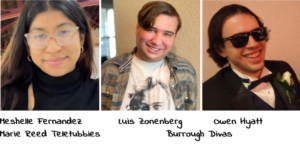My Experience on an FBI Tour

Dion Sinodinos
By Dion Sinodinos
I had the unique opportunity to join the Criminology Club and visit the Federal Bureau of Investigation headquarters here in Washington D.C. on Friday, March 22. The Criminology Club arranged this trip with the help of John Fox, a politics professor within the intelligence certificate program who also works full time at the FBI as a historian.
I personally have always appreciated what FBI agents have done for their country and exploring the J. Edgar Hoover Building was a once-in-a-lifetime opportunity.
Before you can begin the ‘F.B.I. Experience,’ as the tour is called, you must arrive at least half an hour early. Since I am from Australia and not yet a U.S. citizen, I was required to present my passport to the front desk at the Hoover building before I could even be let through to security. Afterwards, I was greeted by John Fox, who was the organizer of the tour.
I had arrived earlier than my fellow students, giving me a unique twenty minutes to take in where I was and to talk to a retired FBI field officer! Although I cannot disclose his name, he shared his personal experiences from the 1980s, such as his work with the Australian Federal Police or when he combated South American drug cartels smuggling illegal substances into Florida during the Miami Drug War. This retired field officer now works as a tour guide at the FBI headquarters.
Soon afterward, we were greeted with a video from the director of the FBI, Christopher Wray, welcoming us visitors to the FBI Experience. We were then led to this closed-off courtyard that had an outdoor gym, a Starbucks, and outdoor seating areas. It reminded me of one big college campus! Along the way, our guide, also a working agent with the FBI, told us about the exhibits available, including spy equipment from a bygone era and the actual boat Dzokhar Tsarnaev, the second Boston marathon bomber, was found in. As a history buff, this was truly an exhibit to look forward to.
We later found ourselves in another part of the building where the main exhibit was held, which was put together with the help of the Smithsonian Institute. The first part of the exhibit had plastic tubes filled with live bullets. The bullets included shotgun rounds from a Remington 870, rounds from a Glock 19 M, and bullets from a Cold M4 in the third tube. Alongside this exhibit behind a glass case were bulletproof vests, riot shields, and deadly weapons currently in use by active FBI field officers.
Posted along the yellow walls of the exhibit apart from artifacts were the different types of jobs a member of the FBI could do as well as the training they must undergo at the FBI academy at Quantico, Virginia. For example, these posts stated how FBI analysts only needed 12 weeks of training at Quantico, whilst someone aspiring to become a field agent needs 20-22 weeks worth of training. The FBI seems to have a job for every type of person, from scientists to athletes to historians.
In that same room, there was also a closed-off laboratory/evidence room behind an automatic glass sliding door that contained bagged-up items of various backgrounds; we were not permitted under any circumstances to photograph this part of the exhibit.
Further in, I was amazed at the surveillance technology that the FBI has historically used as well as at the countless amazing artifacts that were part of the collection. This included a German cryptologic machine dating back to 1912 and microphones that could be made to resemble everyday objects, such as a power bank, a tie pin, and even a power socket. I also saw artifacts used by Cuban exiles and forensic kits used during bank robbery investigations. The exhibit also contained the personal effects of famous individuals who had unique accomplishments in the intelligence community at some point in the past. Lastly, I got to see the personal effects of Chi Mak, an engineer who was also giving the Chinese government access to documents relating to American defense technology.
The most amazing and moving part of this exhibit, however, were the artifacts from 9/11. The 9/11 exhibit included various personal effects from the destroyed towers, such as cellphones, revolvers, handcuffs, a street sign from ground zero, the rubber wheel of a destroyed fire truck, the door of an NYPD cruiser, and a portion of the turbine blades from one of the planes that crashed into the twin towers. At the very end of the tour, our group was informed of the ‘Honors Internship Program,’ a unique opportunity to intern for the FBI in the summer of 2025.
Touring the FBI headquarters was an enriching experience for me since I wish to pursue a career in the intelligence community. What I took from this experience was how much the FBI looks out for this country. The work every agent puts in and the sacrifices that have been made are definitely noteworthy of our praise.
For more information on the Certificate in Intelligence Studies, please visit the university’s website.
Images by Dion Sinodinos:
Slipaway II: the boat Dzokhar Tsarnaev was found in.
Portion of a plane turbine blade found at Ground Zero.
Chi Mak’s day planner used to record the movement of the U.S. Naval Ships.





